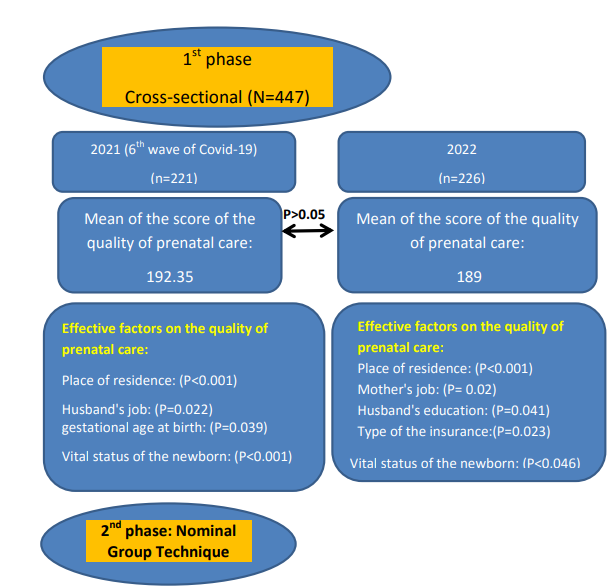Volume 35, Issue 246 (7-2025)
J Mazandaran Univ Med Sci 2025, 35(246): 95-106 |
Back to browse issues page
Download citation:
BibTeX | RIS | EndNote | Medlars | ProCite | Reference Manager | RefWorks
Send citation to:



BibTeX | RIS | EndNote | Medlars | ProCite | Reference Manager | RefWorks
Send citation to:
Khani S, Shahhoseni Z, Nourollahpour Shiadeh M, Nikbakht R, Kalteh A. Comparing the Quality of Prenatal Care During the Sixth Wave of COVID-19 with a Corresponding Period Thereafter: Proposing Optimal Solutions. J Mazandaran Univ Med Sci 2025; 35 (246) :95-106
URL: http://jmums.mazums.ac.ir/article-1-21522-en.html
URL: http://jmums.mazums.ac.ir/article-1-21522-en.html
Abstract: (270 Views)
Background and purpose: Prenatal care is one of the most important health care programs, with a direct impact on maternal and child health. With the outbreak of the COVID-19 pandemic, prenatal care was disrupted. The aim of the present study was to compare the quality of prenatal care during the COVID-19 pandemic with that of the same period before the pandemic, and also to provide recommendations to improve the quality of prenatal care during epidemics.
Materials and methods: This research was conducted in two phases. In the first phase, a cross-sectional study was conducted on 447 pregnant women attending Bandar Turkmen Health Center from 23 October 2021 to 20 March 2022, and during the same period after COVID-19, from 23 October 2022 to 20 March 2023. A prenatal care quality questionnaire was used to collect the data. Mann–Whitney, Kruskal–Wallis, and generalized linear regression tests, as well as SPSS version 23, were used to analyze the data. In the second phase, using the nominal group technique (NGT), the best strategies were identified for managing prenatal care during epidemics.
Results: The average scores for the quality of prenatal care in 2021 and 2022 were 192.35 and 189.00, respectively (P > 0.05). In 2021, factors such as residence (P < 0.001), mother’s occupation (P = 0.020), spouse’s education (P = 0.041), type of insurance (P = 0.023), and newborn’s vital status (P = 0.046) were significantly associated with the quality of prenatal care. In 2022, residence (P < 0.001), spouse’s occupation (P = 0.022), gestational age (P = 0.039), and infant’s vital status (P < 0.001) showed a significant relationship with the quality of prenatal care. The results of the NGT showed that online visits and virtual media can be used to educate and promote the health of pregnant women.
Conclusion: There was no statistically significant difference between the quality of prenatal care during the COVID-19 pandemic and the corresponding period after it. It is recommended that prenatal and postpartum care be provided both in-person and online through virtual platforms and at home.
Materials and methods: This research was conducted in two phases. In the first phase, a cross-sectional study was conducted on 447 pregnant women attending Bandar Turkmen Health Center from 23 October 2021 to 20 March 2022, and during the same period after COVID-19, from 23 October 2022 to 20 March 2023. A prenatal care quality questionnaire was used to collect the data. Mann–Whitney, Kruskal–Wallis, and generalized linear regression tests, as well as SPSS version 23, were used to analyze the data. In the second phase, using the nominal group technique (NGT), the best strategies were identified for managing prenatal care during epidemics.
Results: The average scores for the quality of prenatal care in 2021 and 2022 were 192.35 and 189.00, respectively (P > 0.05). In 2021, factors such as residence (P < 0.001), mother’s occupation (P = 0.020), spouse’s education (P = 0.041), type of insurance (P = 0.023), and newborn’s vital status (P = 0.046) were significantly associated with the quality of prenatal care. In 2022, residence (P < 0.001), spouse’s occupation (P = 0.022), gestational age (P = 0.039), and infant’s vital status (P < 0.001) showed a significant relationship with the quality of prenatal care. The results of the NGT showed that online visits and virtual media can be used to educate and promote the health of pregnant women.
Conclusion: There was no statistically significant difference between the quality of prenatal care during the COVID-19 pandemic and the corresponding period after it. It is recommended that prenatal and postpartum care be provided both in-person and online through virtual platforms and at home.
Type of Study: Research(Original) |
Subject:
Midwifery
Send email to the article author
| Rights and permissions | |
 |
This work is licensed under a Creative Commons Attribution-NonCommercial 4.0 International License. |







